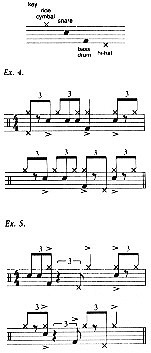Welcome to PaulWertico.com!
Secrets Of Clave
Building Blocks For Jazz Improvisation
When I ask new students to play some jazz time for me, more often than not, they will play the standard dotted-eighth-and-sixteenth ride pattern with some random sounding punctuations on the bass drum and snare. If things are phrased properly, what they play can sound reasonably acceptable.
However, it usually doesn't take long before their playing displays a lack of compositional development. Obviously one remedy for this is to suggest that they think of a tune and play off the tune's melody and form. But I'd like to talk about another approach that can aid in giving you a theme from which to build rhythmic improvisations.
The idea of using a clave pattern as a rhythmic structure is nothing new. Latin music has used several different clave patterns for years. For those who might not know what a clave pattern is, it is a rhythmic pattern, such as:

that is diligently adhered to when playing a song based on that particular clave. This, in turn, gives the music a certain "glue" that holds the composition together. Almost all Latin music is based on some type of clave.
Though some jazz tunes are based on a clave type structure, such as "Phase Dance" by the Pat Metheny Group:

Many times in jazz, the drums will play rhythms based more loosely around the melody and the soloists. Obviously, a part played by a great jazz drummer will have a logic and development that can stand on its own merit. However, young drummers often think that jazz drumming is much more haphazard than it really is, and when they try to play a jazz groove, they end up sounding too sporadic. What I'll do in this case is narrow down the parameters on which to base their rhythms.
For example, the standard jazz ride cymbal pattern implies a 1-2-3-4 type of feel. Now, certainly an infinite number of variations can come out of this pattern. Yet, this freedom to improvise all sorts of independent lines and counter-lines can be the very thing that can confuse and intimidate an inexperienced player. It's a classic case of being overwhelmed by the possibilities. This is where applying clave-type figures really can help. By limiting the possibilities, you instead set up some rhythmic guidelines.

So, for instance, I'll suggest a rhythm such as that in Ex. 3 to be used as a clave-type pattern.
I'll have the student play the rhythm until it sounds and feels right. Then I'll have them continue to think and feel that rhythm while they start to play things based in and around the rhythm. You can keep the figure literally while playing around it, or you can just hint at it enough so you still can feel the figure inside what you're playing. You can try having the clave played by one limb while the other limbs improvise around it. You can also play the standard jazz ride pattern and base your bass drum, snare, and hi-hat improvisations around the clave (see Ex. 4). Or you can play a variation of the ride pattern based on the clave rhythm itself (see Ex. 5).
The object is to develop the ability to create and play different types of grooves based on a clave-type pattern, and to improvise coherent variations based on those grooves, using the clave as the foundation. There are so many patterns from which to choose. Most rhythms can be used successfully, but start out simple. Later, as you become more proficient, you can start to use two-bar, three-bar, four-bar rhythmic phrases, and so on, to add to your ability to improvise in a rhythmic structure. It's also a great way to work on odd meters. The possibilities are endless.

Once you start using this technique, you'll become more aware of the subtleties of jazz improvisation. It will increase concentration, as well as rhythmic awareness and development. It also should aid in your execution of big band music, since some of the clave patterns will be similar to big band type figures.
Finally, it should aid in dispensing with the notion that jazz is just "ding dinga ding"!
Images and Information from Drums & Drumming May 1991, page 60